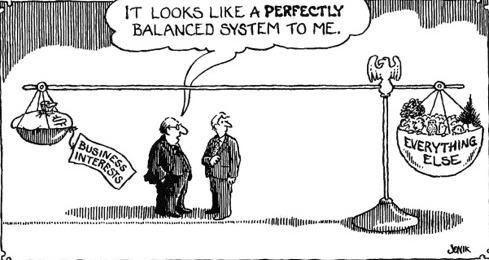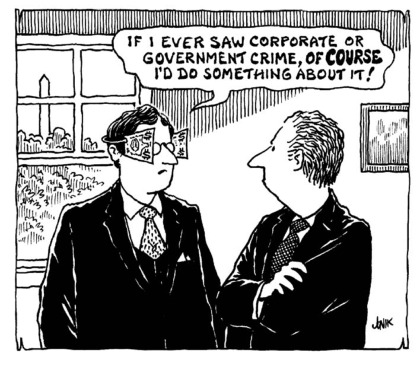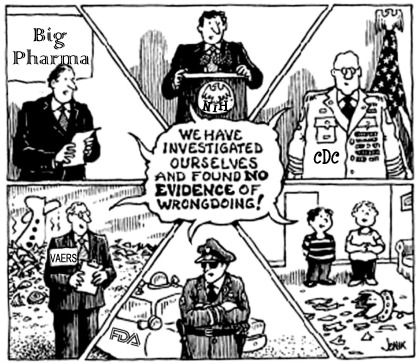
Graphic by Jonik Editorial Cartoons
Never unvaccinated controls Conflict of interest Institute of Medicine (IOM)
Conflicts of interest are rampant in vaccine research. How and why they exist are the topic of a journal article reviewed here. This is why research that could prove that vaccines are safe hasn’t been done.

A new report published in the journal, Accountability in Research, reviews and discusses all areas of conflicts of interest in vaccination research. The author paints a very dark picture, but it’s one that cannot be legitimately denied. Conflicts of interest have resulted in research that isn’t worthy of the term.
Gayle DeLong, the author of Conflicts of Interest in Vaccine Safety Research, frankly spells out her own conflicts. She is the mother of two children with pervasive developmental disorders. She has filed a petition in the U.S. Court of Federal Claims under the National Vaccine Injury Compensation Program for one of her daughters. She is a former member of the board of directors of Sensible Action for Ending Mercury-Induced Neurological Disorders (SafeMinds).
She doesn’t point out her career qualifications for the article. She holds a Ph.D. in Finance and International Business from the Stern School of Business, New York University. Regulated industries are an area of her expertise. Her work has been published in the Journal of Financial Economics, the Journal of Finance, the Journal of Toxicology and Environmental Health, and the Journal of International Money and Finance. She is well qualified to discuss the issue of conflict of interest in the vaccination industry.
DeLong investigates conflicts of interest for every imaginable entity involved in vaccine research and safety.

The conflict of interest (COI) among vaccine manufacturers is fairly obvious. Worldwide sales of pediatric vaccines alone were $11.5 billion in 2009, and it’s expected to reach $20 billion by 2014. The usual risk of lawsuits when products go bad and cause injury doesn’t help curb ineffective or unsafe vaccines because The National Childhood Vaccination Injury Act of 1986 indemnifies them in the event of injury. This waiver was given because pharmaceutical corporations were refusing to develop new vaccines, saying that they were not profitable.
The one arena in which pharmaceutical manufacturers express concern about safety is the potential loss of sales. DeLong tells the tale of Maurice Hilleman, a vaccine researcher for Merck. In an internal memo in 1991, he reported that some countries were considering a ban on thimerosal, a mercury-containing preservative. He said that he didn’t know if thimerosal is dangerous. However, he warned that public perceptions could affect sales. The one concern Hilleman expressed had nothing to do with investigating whether mercury was safe, but whether the company should reduce the amount of thimerosal in vaccines because of public perceptions.
The influence of vaccine manufacturers is ubiquitous. They sponsor research and researchers. A survey of the top US medical research institutions found that over two-thirds of the researchers received industry support. Unsurprisingly, studies have shown that researchers tend to get results that coincide with their financial interests.
Entire institutions are affected by pharma money. Whether it comes in the form of grants, endowed chairs, or other goodies, the results sway entire institutions to get on board with what pharma wants.
A more subtle form of control is pharma giving the bulk of their university-related money to senior and well-established researchers who played ball with them. A clear message is sent to younger researchers that they must play the same game.
Authors of research papers do not always disclose all their associations with pharma corporations, leaving the reader unaware of potentially worrisome connections. This echoes Big Tobacco’s ability to find researchers willing to compromise themselves by calling smoking safe.
Big Pharma’s influence is ubiquitous in every arena where it has an interest. As a result, most published vaccine-related research is questionable.
DeLong points out that the FDA’s mission inherently results in conflict of interest. It states that the first mission is to protect:
… the public health by assuring the safety, efficacy, and security of human and veterinary drugs. … The FDA also helps the public get the accurate, science-based information they need to use medicines and foods to improve their health.”
The FDA has approved the vaccines used in the US. If the agency were to sponsor a study that demonstrates a link between autism and vaccinations, it could, according to DeLong, “greatly damage the Administration’s reputation and reduce public trust in the FDA.”
The manner in which the FDA is funded creates a major COI. The 1992 Prescription Drug User Fee Act requires pharmaceutical companies to pay fees for evaluation of their drugs. Although vaccines are not specifically included in this act, the fact is that most pharmaceutical companies that make vaccines also make drugs—and those fees for drugs certainly help make the FDA friendly towards them.
Parents of vaccine injured children can file claims in the Division of Vaccine Injury Compensation (DVIC), which is a division of the Department of Health and Human Services (HHS). The FDA is also a division of HHS. If the FDA provided information that could support DVIC claims, it could also be used against the FDA.
This is an arena where we can be sure that a significant COI exists. DeLong states:
As of December 2011, over 5,600 autism claims have been filed in DVIC. The average payout for vaccine-related injuries is close to $825,000 (DHHS,2011), so the autism claims could cost the Program over $4.6 billion. Additionally, more parents would seek compensation if DVIC recognized autism as a vaccine injury.
If we consider how many children are now found to have autism—with the CDC now estimating 1 in 88—it seems obvious that DeLong’s estimate of DVIC being at risk to the tune of $4.6 billion is extremely low. The number of children in the US is now about 89 million. That’s well over a million children with autism. Over $825 billion dollars could be due these families! That’s nearly a trillion dollars—and it doesn’t include all the children with other conditions that are likely related to vaccines. Once the flood doors open on autism, they’d remain open. This is a nation-busting issue—and that’s one stunning conflict of interest!
In my view, this is the most significant conflict of interest. To admit that vaccines cause autism and other severe disabilities would put the government in an unsustainable position, both morally and financially. Thus, no admission of such a connection will be made.

The CDC’s conflict of interest is inherent in the mandates that it’s charged with. The agency is charged with preventing and controlling disease, injury, and disability. The primary method by which they attempt to control disease is through promoting vaccination. Upon FDA approval, they set the recommended vaccination schedule. But they’re also charged with doing research on vaccine safety.
So, if the CDC promotes vaccinations without first assuring their safety, how can they also control disabilities caused by vaccines? Obviously, there’s a conflict of interest. To admit that its own policy of vaccination is the cause of autism would mean that the CDC doesn’t actually support its goal of preventing disability, that it’s actually causing it. Therefore, it’s no surprise the the CDC is not inclined to support genuine research into vaccine safety.
Officials at the CDC are noted for using their term at the agency as a stepping stone to extremely high-paying positions with the pharmaceutical industry. Julie Geberding was the CDC’s Director from 2002 to 2008. During her tenure, she promoted vaccination heavily. As soon as the one-year time span for taking a position with Big Pharma had elapsed, she became president of Merck Vaccines. The use of the CDC as a career path to bigger and better things within the industry that’s supposedly being regulated is an obvious conflict of interest.
The IOM is, presumably, an independent nonprofit agency. However, it does take grants from the CDC. Therefore, when it was tasked by the CDC to do a study on whether there might be a connection between vaccines containing thimerosal and autism, they knew on which side their bread is buttered.
Dr. Marie McCormick, who was Chair of the IOM’s Immunization Safety Review Committee, stated of the proposed study:
[W]e are not ever going to come downthat [autism] is a true side effect [of vaccines].
As DeLong points out, she was declaring their conclusion before even performing the study!
In their final report, The IOM evaded the issue. They said that, though a link between autism and vaccines was “theoretically possible”, no causal link had been found in epidemiological studies. Therefore, they suggested that it would be better to channel funds for such a study to “more promising areas of research”.
Notice that they made a statement that is, on its face, absurd. Causation is not found through epidemiological studies! Associations are, but causation—though there may seem to be an obvious cause-and-effect connection—is not formally ascertained through such a study. This merely highlights that the IOM clearly wanted to be clear of doing that study about vaccine safety. If they found a connection to autism, then they’d risk losing grants.
Members of congress receive significant contributions from pharmaceutical and health products industries. These contributions have been growing at an enormous rate. Members of congress are fully aware that they must capitulate to their financers if they’ve any hope of being reelected. But that’s probably even less important than that many members of congress go on to very lucrative positions as lobbyists with these same pharma corporations. Since most of them don’t spend their lives representing the folk back home, instead moving on to other things that result from their congressional tenure, they aren’t likely to bite the hands that feed their nice lifestyles.
It should come as no surprise that members of congress are shy about doing anything critical of the pharmaceutical industry. Should they attempt to mandate a study that might have a negative impact on the profits of Big Pharma, they aren’t going to get the donations needed to get re-elected, nor are they going to receive lucrative offers after leaving.
DeLong states:
Medical journal authors’ ties to vaccine manufacturers are pervasive, as revealed in a review of authors of vaccine safety articles published in top journals. …
… Not only authors, but also journals themselves can be conflicted. Washington (2011) details thereliance of medical journals on advertising from pharmaceutical companies, which can account for up to 99% of a journal’s advertising revenue.
She quotes Fiona Godlee, editor-in-chief of the BMJ:
Even on the peer-reviewed side of things, it has been said that the journals are the marketing arm of the pharmaceutical industry. That is not untrue. To a large extent, that is true.
Basically, medical journals are one big conflict of interest.
VAERS is the US’s system for reporting adverse events resulting from vaccines. By its nature, it’s not entirely reliable. However, it most likely reflects a small proportion of the adverse events that afflict people after vaccinations. One would expect that there would be a purpose for collecting all this data.
As must be painfully obvious at this point, vaccines are not adequately studied, especially in terms of safety. As DeLong states:
[N]o research sponsor has supported a large-scale study of the prevalence of autism among vaccinated versus unvaccinated children, nor are vaccination records included in prospective studies.
The subject is studiously avoided. As DeLong points out, the Columbia Center for Children’s Environmental Health sponsors studies on prenatal and postnatal environmental toxic exposures to search for possible adverse effects on health. They investigate all sorts of things, but vaccines are never on the list. Another such study, the National Child Study, investigates environmental factors in children’s health, but they don’t consider vaccines, either.
And no large studies have been launched to utilize VAERS data—with the exception of a few intrepid souls, like Michael Belkin, who take it on themselves. It shouldn’t be surprising, though. Conflicts of interest related to vaccination are pervasive. The easiest way to avoid finding something that you don’t want to find is not to look for it—and that brings us to the elephant in the vaccine room.
Those of us who read studies on vaccines are often stunned at the poor quality and their apparently intentionally misleading nature. The reason for it becomes apparent once we’re aware of the pervasiveness of conflicts of interest. What’s amazing is that some good information comes out, anyway.
Still, most of what’s investigated is things like titers, the level of antibodies that result from vaccines, with associated assumptions about whether they’re adequate—but without any demonstration of why those particular figures were chosen or if, indeed, they actually do represent immunity. When it comes to safety, studies are done in exceptionally dishonest ways. Two favorites are to do only short-term investigations or to make comparisons utilizing active placebos. That is, the placebos contain many of the same substances that are believed—even known—to cause adverse reactions.
Still, as bad as these studies are, they’re done and trotted out as evidence for both efficacy and safety of vaccines. However, one kind of study is never done. No large-scale comparison between vaccinated and unvaccinated children is ever done.
Considering how blatantly vaccine research is gamed, there can only be one reason for this lack: The distinction between the two groups is so dramatic that all of the techniques used to twist results cannot hide the reality. The vaccine elephant is the comparison between the two groups. Such a study would not be difficult to put together. There are groups of people who are almost all unvaccinated: the Amish, the thousands of children who’ve attended Dr. Eisenstein’s Homefirst Clinic, and a large group of children spread out in several countries who have attended Waldorf schools.
The elephant in the vaccine research room is the comparison of health between vaxxed and unvaxxed people. That research simply isn’t being done, in spite of being the obvious way to determine whether vaccines are safe or lead to better health.
There’s one near-sure way to avoid finding something, and that’s not to look for it.
The lack of research that could end the question of whether vaccines are safe simply isn’t being done. The reason is obvious: Those who could do it won’t because it would conflict with their careers and financial status.
All graphics are from Jonik Editorial Cartoons.